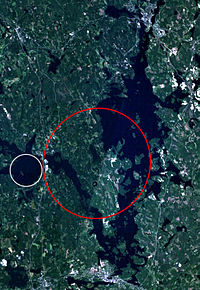
Photo from wikipedia
ABSTRACT A study of the fracture systems in the basement of the Matatlan urban waste dump of Guadalajara City, near the western edge of the Rio Grande de Santiago canyon… Click to show full abstract
ABSTRACT A study of the fracture systems in the basement of the Matatlan urban waste dump of Guadalajara City, near the western edge of the Rio Grande de Santiago canyon (southwestern Mexico), is reported. The Matatlan dumpsite was developed on top of andesitic and rhyolitic rocks. Measurements at outcrops indicated that N–S (0°–15° and 165°–180°), N45–90E and N105–135E fracture systems affect the basement. Statistical analysis (micromagnetic method) of magnetic lineament azimuths indicated the presence of two lineament groups. The major one (N60–120E) has a maximum at N90–105E, and a secondary group (N120–165E). The gravity anomalies are featured by a major group (N60–120E, with maximums at N60–75E, and N105–120E) and a secondary group (N120–180E). Thus, a good to fair correlation exists between the measured fracture orientations and the lineaments featuring the gravity and magnetic anomalies. Horizontal derivative and tilt angle depicted horizontal limits of anomaly‐causative bodies. Results of the micromagnetic method are consistent with fracture orientations and with the limits established through edge‐detection techniques. Lineaments established by means of the gravity and magnetic Euler deconvolution are also consistent. Gravity and magnetic Euler deconvolution helped to estimate the depth extent of the limits of gravity and magnetic common sources. Euler deconvolution indicated the fault or contact nature of these lineaments. Furthermore, Euler deconvolution indicated slopes of the limits of gravity and magnetic sources. The fault or fracture nature of the major lineaments was finally confirmed by forward modelling (forward 2D cooperative modelling of gravity and magnetic profiles). For example, lineaments delimiting the northern depression could be characterized as normal faults. In general, this study indicates that it is possible, based on gravity and magnetic data, to characterize fractures affecting the basement of a dumpsite, a key parameter in hydrogeophysical studies. In particular, through this study, the inferred structures could be associated with regional tectonic faulting, which might provide migration paths to unhealthy lixiviate outside the dumpsite, giving rise to the contamination of the neighbouring environment. In particular, the study explains the presence of an unhealthy leachate waterfall to the northeast of the dumping site. Heavy metal contents in samples from this waterfall support that lixiviates originate at the dumpsite.
Journal Title: Near Surface Geophysics
Year Published: 2020
Link to full text (if available)
Share on Social Media: Sign Up to like & get
recommendations!